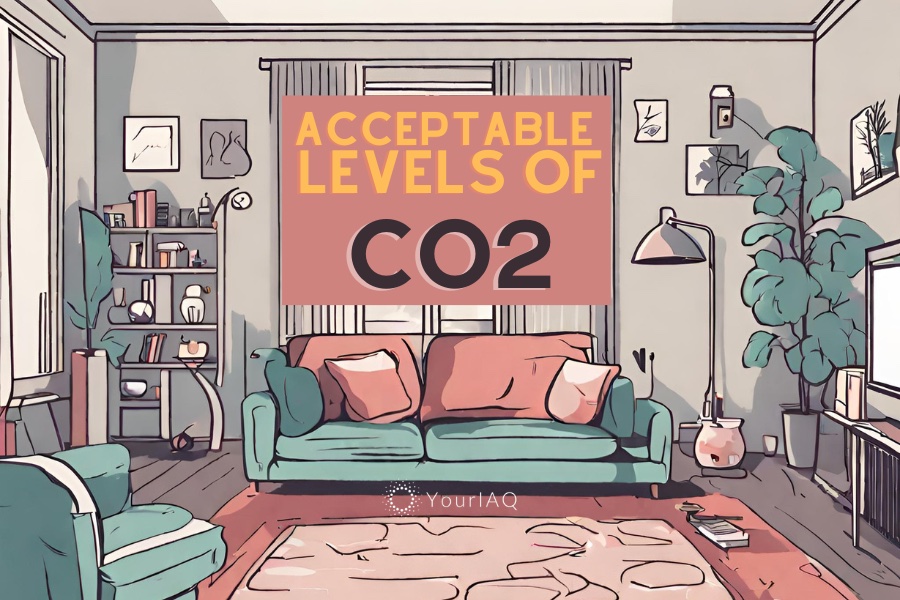
When it comes to ensuring a safe and healthy indoor environment for your family, one often overlooked factor is the level of carbon dioxide (CO2) in your home. Many of us are aware of the importance of proper ventilation and air quality, but understanding what constitutes an unhealthy CO2 level is equally crucial. In this beginner’s guide, we’ll delve into the recommended CO2 levels for indoor spaces, the health effects of high CO2 levels, how to measure CO2 levels, and what you can do to reduce them.
What is the Recommended CO2 Level for Indoor Spaces?
CO2 is a naturally occurring gas that is the main source of carbon to support all life on earth. While it is a necessary component of a healthy ecosystem, carbon dioxide can negatively impact human health when it is present in higher than normal concentrations.
The recommended CO2 level for healthy indoor spaces typically falls within the range of 350 to 1,000 parts per million (ppm). However, it’s essential to note that the specific recommended levels can vary depending on the purpose of the space. Here’s a breakdown of typical CO2 levels:
- 350-450 ppm: Ideal CO2 levels for well-ventilated outdoor air.
- 450-600 ppm: Excellent indoor air quality with ample ventilation.
- 600-1,000 ppm: Acceptable levels for most indoor spaces but may indicate a need for increased ventilation.
- Above 1,000 ppm: Elevated CO2 levels that may lead to health concerns if sustained.
These recommendations are established to ensure a healthy and comfortable indoor environment, as elevated CO2 levels can have adverse effects on our well-being.
Source: https://www.co2meter.com/en-es/blogs/news/co2-levels-at-home-tester
What Are the Health Effects of High CO2 Levels?
Exposure to high CO2 levels can lead to a range of health issues, particularly when those levels persist over time. Some common health effects associated with elevated CO2 levels include:
- Headaches: Increased CO2 can lead to headaches, dizziness, and a feeling of discomfort.
- Fatigue: High CO2 levels can make you feel tired and sluggish, reducing productivity.
- Reduced Cognitive Function: Prolonged exposure to elevated CO2 levels may impair cognitive function and decision-making.
- Shortness of Breath: Breathing can become more challenging in areas with excessive CO2.
- Irritation: Irritated eyes, nose, and throat can occur, resembling allergy symptoms.
- Long-Term Health Risks: Chronic exposure to high CO2 levels may contribute to respiratory conditions and cardiovascular problems.
To ensure the well-being of your family, it’s crucial to monitor and control CO2 levels in your living spaces.
Source: https://www.nature.com/articles/s41893-019-0323-1.epdf
How Can I Measure CO2 Levels in My Home or Office?
Measuring CO2 levels in your home or office is a straightforward process thanks to modern technology. You can use a CO2 monitor or detector to get an accurate reading of the CO2 concentration in the air. Here’s how you can do it:
- Purchase an IAQ Device by Sensables.io to Monitor CO2 and other indoor air pollutants.
- Set up alerts through the easy monitoring through your phone.
- Place the Monitor Strategically: Position the monitor in a central location within the room, away from windows, doors, and vents.
- Monitor and Interpret Readings: Regularly check the monitor’s readings through your smartphone and use alerts. If the levels consistently exceed the recommended range, it’s time to take action.
What Can I Do to Reduce CO2 Levels in My Home or Office?
Maintaining proper ventilation is the key to reducing CO2 levels in indoor spaces. Here are some effective strategies to help you achieve this:
- Open Windows and Doors: Whenever possible, allow fresh outdoor air to circulate through your home or office.
- Use Exhaust Fans: In areas like kitchens and bathrooms, use exhaust fans to expel indoor air laden with CO2.
- Invest in Air Purifiers: High-quality air purifiers can help remove CO2 and other pollutants from the air.
- Plants: Certain indoor plants, like snake plants and peace lilies, can naturally help reduce CO2 levels by absorbing carbon dioxide and releasing oxygen.
- Limit Indoor Activities: Minimize activities that generate CO2 indoors, such as excessive use of gas stoves or fireplaces.
- Visit a Clean Air Center: In times of extreme indoor air quality issues, some cities and municipalities offer clean air centers that are open to the public.
Frequently Asked Questions
What CO2 level is dangerous?
A CO2 level consistently above 1,000 ppm is considered dangerous and can lead to health issues if not addressed.
Is CO2 a pollutant?
No, carbon dioxide is not a pollutant. In fact, CO2 is necessary to sustain all life on earth. However, CO2 levels can increase to unhealthy levels in poorly ventilated spaces due to various activities. It’s important to manage CO2 levels to prevent too much exposure over long periods of time.
Can high CO2 levels be harmful to children?
Yes, high CO2 levels can be harmful to children, just as they are to adults. Children may be more sensitive to changes in indoor air quality.
Does high CO2 indoors create an economic burden on society?
Research shows high levels of CO2 in indoor spaces can reduce the amount of oxygen available for brain function, which contributes to decreased alertness and productivity. Better management of pollutants such as CO2 could create massive economic benefits for society as a whole.
Are there government guidelines for indoor CO2 levels?
Yes, various government agencies, such as the Environmental Protection Agency (EPA), provide guidelines for indoor CO2 levels to ensure a healthy living environment.
Can I use indoor plants to reduce CO2 levels?
Yes, certain indoor plants can help reduce CO2 levels by absorbing carbon dioxide during photosynthesis.
Do I need a professional to measure CO2 levels in my home?
While it’s not necessary to hire a professional to measure CO2 levels, using a reliable CO2 monitor is recommended for accurate readings.
Maintaining Healthy CO2 Indoors
Maintaining acceptable levels of CO2 in your office or home is essential for the well-being of your family and yourself. By following the recommended guidelines, regularly monitoring CO2 levels, and implementing effective ventilation strategies, you can ensure a safe and healthy indoor environment. Don’t underestimate the importance of indoor air quality, as it plays a significant role in your overall health and comfort.







